Introduction
Airbnb is a privately-owned global enterprise founded in 2008 and specialized in hospitality services. It runs an online marketplace by using a sharing economy model that provides users from around the globe with a chance to rent out their properties and gain profits from rendering tourism services at varying prices. Additionally, it allows travelers to find diverse and affordable accommodation options.
According to the company’s statement, nowadays, the Airbnb marketplace gives access to “5+ million unique places to stay in more than 81,000 cities and 191 countries” (Airbnb, n.d., para. 1). Considering the organization’s orientations and service offers, its target market is highly versatile in terms of demographics. For instance, the group of senior users is the fastest growing in Airbnb and currently comprises over 200.000 hosts (property management, 2018). As for the group of guest users, it includes people from different backgrounds, yet the main common feature among them is interested in traveling and familiarity with modern information technologies.
Social Media Activity
Airbnb implements a very effective social media marketing strategy and is active across multiple platforms, including Facebook, Instagram, Twitter, YouTube, LinkedIn, and so forth. According to Hogan (2018), the main aspects of the firm’s strategy are video marketing, the integration of user-generated content (UGC), and the use of social channels for customer communication. YouTube, Instagram, and Twitter are the main media where Airbnb realizes these activities and, therefore, the analysis in this section will focus on them.
Company Reach
Among the three chosen platforms, the number of Airbnb followers is the highest on Instagram and amounts to 3.8 million users (Figure 1). On Twitter, the company has 638 thousand followers (Figure 2) and, on YouTube – 168 thousand (Figure 3). As for the number of views on social media, it ranges from one video to another. For instance, within the period of the last 12 months, the most frequently watched clip received 10 million views, and it was a 30-second commercial clip.
It is likely that this video content was actively shared by Airbnb across other platforms and websites. Moreover, the video features recognizable Indian actors, which defined its popularity. At the same time, the average number of views on both YouTube and Twitter ranges from 20 to 70 thousand. Since on Instagram, the company mainly posts images, its reach on this platform will be analyzed by the number of likes in the Feedback section.
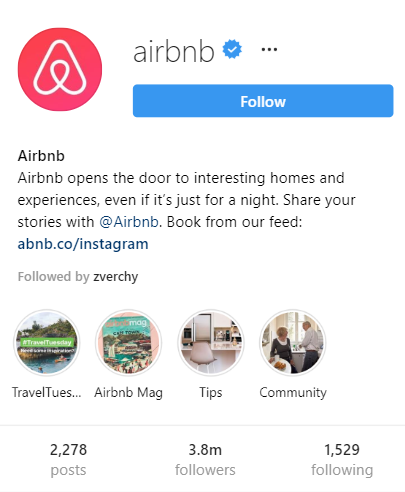
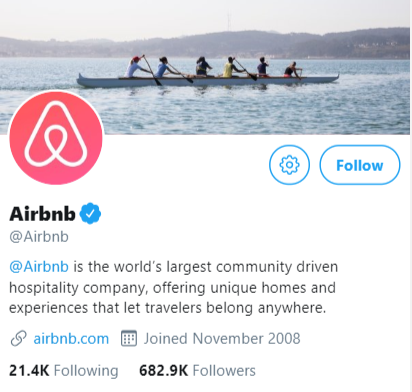
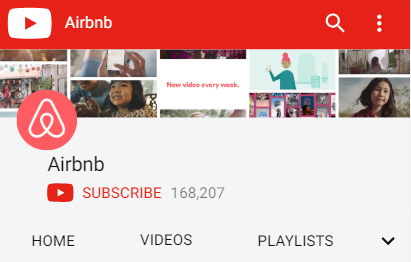
Company Posts
Airbnb pays significant attention to the quality of its content and does not compromise it by trying to post more frequently on each platform. For instance, the company usually posts several YouTube videos monthly but can sometimes take few-month breaks between posts. The main reason for this is that video production is time-consuming and normally requires significant financial investments. Conversely, the utilization of UGC is not associated with such disadvantages, and, thus, this approach allows Airbnb to post at least once a day on Instagram. Noteworthily, by posting other users’ photos, the company adds value to its customers and creates a more human-oriented brand image.
Moreover, in this way, Airbnb’s Instagram content is characterized by a high level of originality and aesthetic appeal. Lastly, Twitter uses the same strategy when creating and sharing content like on Instagram in addition to posting promotional content and company news. Nevertheless, the company’s posts are less frequent there. It is possible to presume that this situation may be determined by the overall greater popularity of Instagram among modern users and the firm’s lower reach on Twitter.
Feedback
Airbnb receives the highest number of comments and likes on Instagram. For instance, within the period of slightly over twenty-four hours, one of the recent posts was liked 45,800 times and was commented 510 times (Figure 4). It is quite common for the company to get feedback of such intensity and speed on its Instagram page. Again, the quality of content, its aesthetic appeal, as well as the attractiveness of the UGC concept to the platform users is that what define Airbnb’s social media success in this case.

As for the other two platforms, users’ feedback there is rather modest compared to Instagram. On Twitter, only the pinned post gets a few thousands of likes and several hundreds of reposts, while the regular posts in the feed seem to be less engaging. The same goes for YouTube: in spite of a superb content quality, people are rarely engaged in commenting or evaluating it. Thus, the firm’s situation in terms of feedback on these two platforms is less successful.
Average Response Time
When it comes to customer service through social media, Twitter is a key tool for Airbnb. It has launched the Airbnb Help page specially intended to reply to customers’ questions and concerns as quickly as possible. On average, it takes about 15 minutes or less for the company to respond to each person (Figure 5).
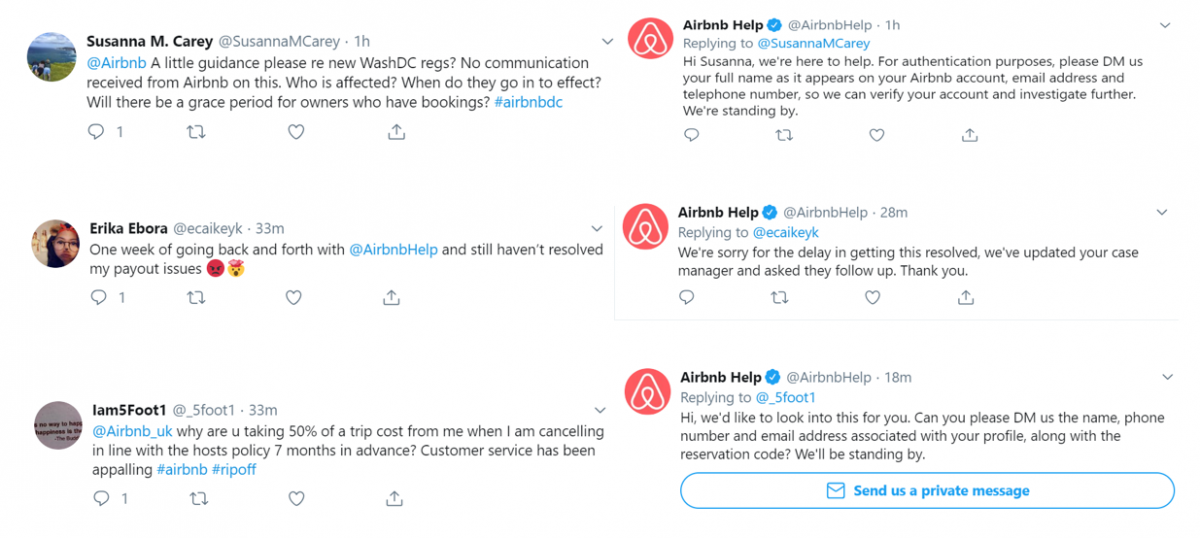
Regardless of the fact that it deals primarily with negative messages, including those about poor customer service, it is valid to say that Airbnb responds to users’ Tweets very fast. At the same time, there is no sign of it responding to users’ comments and questions on Instagram and YouTube, which indicates that it does not regard these platforms as a means for communication.
Sentiment Analysis
For sentiment analysis, such tools as Word Cloud and LIWC were applied. The former provided a visual representation of the most frequently utilized words in users’ comments on one of the recent Instagram posts by Airbnb (Figure 6), while the latter instrument analyzed the emotional tone of these comments.
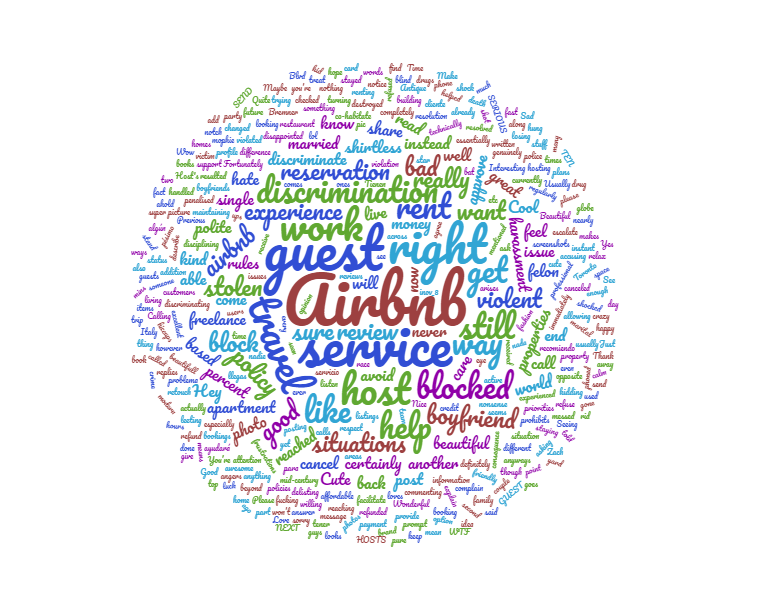
It is clear from the presented image that the most frequently used words (the larger ones) are either neutral or negative in emotional tone. The negative ones include “discrimination,” “violence,” “stolen,” “harassment,” and other items that were chosen by customers to share their negative experiences with the company. It is worth noticing that a lot of positive comments are not reflected in the cloud merely because users expressed themselves through emojis, which were, however, considered during the LIWC analysis. As a result, the emotional tone of all comments under the same post combined was estimated as more positive than negative (Figure 7).
Nevertheless, it is possible to say that emotions expressed through words contain much more meaning, and, thus, Airbnb’s failure to address users’ concerns in Instagram comments, as it does on Twitter, may have a harmful effect on the brand’s image.

Conclusion
It is valid to conclude that different platforms are utilized by the company for distinct purposes. While it is true to say that all three of the analyzed social networks are implemented for promotion, it seems that, through Instagram and YouTube, Airbnb strives to build its brand and stimulate user engagement and, through Twitter, it aims to communicate with customers and improve their experiences. It largely succeeds in doing so, yet the firms’ social media strategy has some flaws. The major one is the lack of response to all negative comments on Instagram, which may undermine Airbnb’s current branding efforts.
References
Airbnb. (n.d.). About us. Web.
Hogan, M. (2018). Social media highlight: Airbnb. Stunning Strategy. Web.
iPropertyManagement. (2018). Airbnb statistics for demographics and growth. Web.